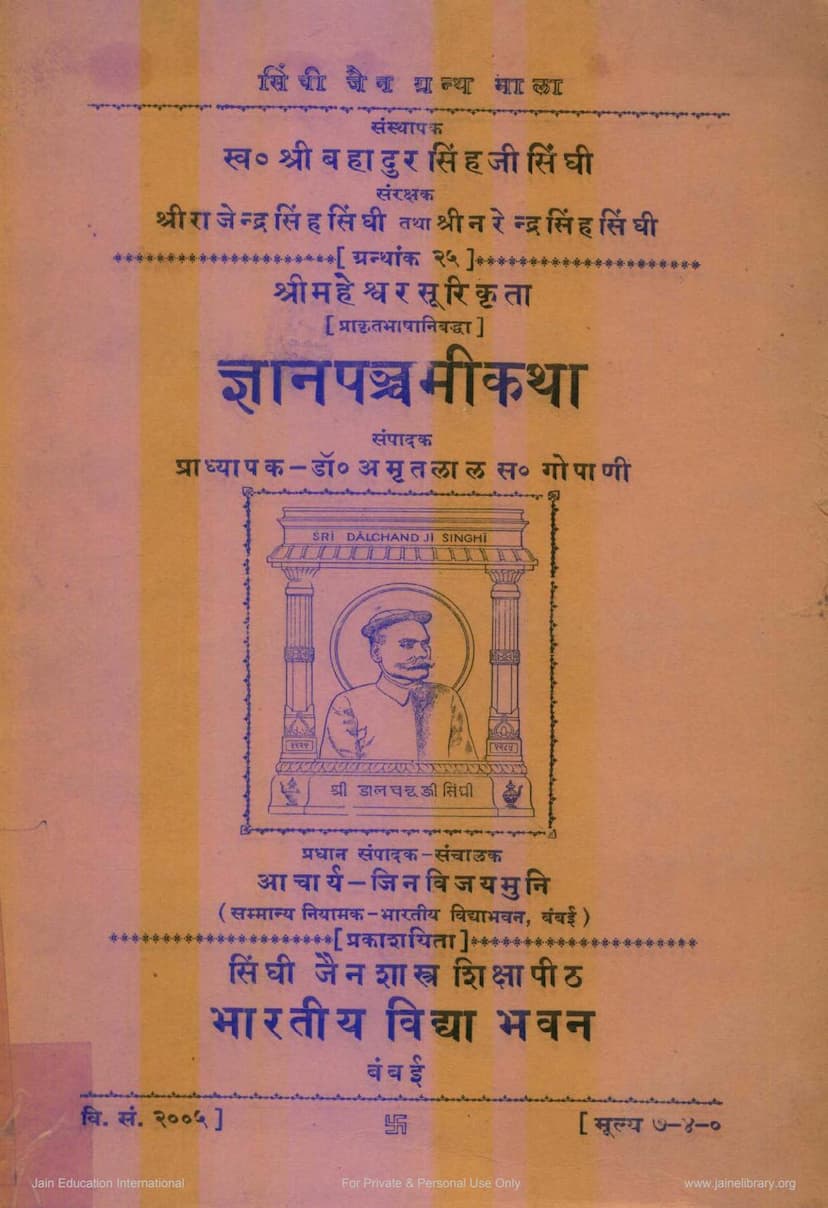Gyanpanchami Katha
Added to library: September 1, 2025

Summary
This is a summary of the Jain text "Gyanpanchami Katha" by Maheswarsuri, published by Singhi Jain Shastra Shiksha Pith Mumbai.
The book is part of the Singhi Jain Granthamala series (volume 25) and was published in V.S. 2005 (1949 AD). It is edited by Professor Dr. Amritlal S. Gopani. The publication is dedicated to the memory of Babu Bahadur Singh Singhi, who was instrumental in establishing the Singhi Jain Granthamala.
Key Points from the Text:
- Author: Maheswarsuri
- Title: Gyanpanchami Katha (also referred to as Nannapanchami Kaha or Panchami Katha)
- Publisher: Singhi Jain Shastra Shiksha Pith, Mumbai (under the aeg1. Book Title: Gyanpanchami Katha
- Author: Maheswarsuri
- Publisher: Singhi Jain Shastra Shiksha Pith, Mumbai
- Series: Singhi Jain Granthamala, Number 25
- Editor: Professor Dr. Amritlal S. Gopani
- Publication Year: V.S. 2005 (1949 AD) / 1949 AD
- Language: Prakrit (Prākrita) with extensive Gujarati introduction, commentary, and appendices.
Content Summary:
The "Gyanpanchami Katha" is a Prakrit text that focuses on the significance of the "Gyanpanchami" (Knowledge Fifth) vow. The book contains ten narrative sections (adhyāyānas) that illustrate the importance of this vow. The author, Maheswarsuri, aims to explain the merits of observing this vow, highlighting how it can lead to various positive outcomes such as prosperity, auspicious births, freedom from illness, union with loved ones, release from bondage, and ultimately, liberation (moksha).
The text is structured into ten distinct stories, with the first and last being the longest (500 stanzas each), and the remaining eight being shorter (125 stanzas each), totaling approximately 2000 stanzas. Maheswarsuri uses verses (gathas) in Maharashtri Prakrit, with occasional influences from Ardhamagadhi and Apabhramsha.
Key Narratives and Themes:
The ten stories within the "Gyanpanchami Katha" are:
- Jayasen Katha: Illustrates the auspiciousness of adhering to the vow, leading to desirable outcomes.
- Nanda Katha: Focuses on the results of vows and adherence to religious practices, contrasting worldly desires with spiritual attainment.
- Bhadra Katha: Highlights the power of the vow and divine intervention in overcoming adversity and achieving liberation.
- Vira Katha: Depicts the consequences of actions and the importance of righteous conduct, emphasizing how devotion and vows can lead to salvation.
- Kamala Katha: Details the story of Kamala and her unwavering devotion to the vow, leading to her liberation.
- Gunanuraga Katha: Emphasizes the virtue of devotion and righteousness, showing how adherence to principles leads to spiritual progress.
- Vimala Katha: Illustrates the purification of the soul through the vow and righteous actions, leading to spiritual enlightenment.
- Dharana Katha: Focuses on the importance of vows and their impact on one's destiny, showing how righteous actions lead to liberation.
- Devi Katha: Narrates the story of Devi and her spiritual journey, highlighting the transformative power of devotion.
- **Bhavishyada